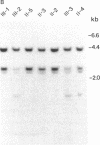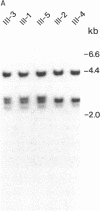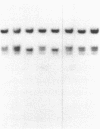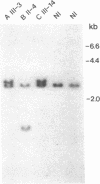Abstract
Hereditary angioneurotic edema (HANE) results from the deficiency of the inhibitor of the first component of human complement (C1-INH). It is inherited as an autosomal dominant trait. Heterogeneity of this defect has been shown at the protein and mRNA level. Southern blot analysis of genomic DNA was performed after digestion with six different restriction endonucleases in 24 families affected with type 1 HANE (low antigenic and functional C1-INH levels) and five with type 2 (low functional C1-INH levels and normal or elevated levels of dysmorphic C1-INH). Blots were hybridized with a C1-INH cDNA probe of 1,227 bp. With one enzyme (Pst I), two different patterns of restriction fragment length polymorphism (RFLP) were detected. One was present in one kindred with type 1 HANE and the other appeared the same in one type 1 and in one type 2 family, thus indicating that each RFLP resulted from a different mutation. Analysis of a total of 34 members of these three families suggested that the polymorphisms are tightly linked to the mutation responsible for the disease. Using a 170-bp probe we showed that the three different mutations leading to these polymorphisms are located in the same region of the C1-INH gene. These data suggest that different mutations in the same region of the C1-INH gene are responsible for C1-INH deficiency in these families. Most of these mutations are probably point mutations or other "minor" defects and do not appear to be due to major deletions or rearrangements.
Full text
PDF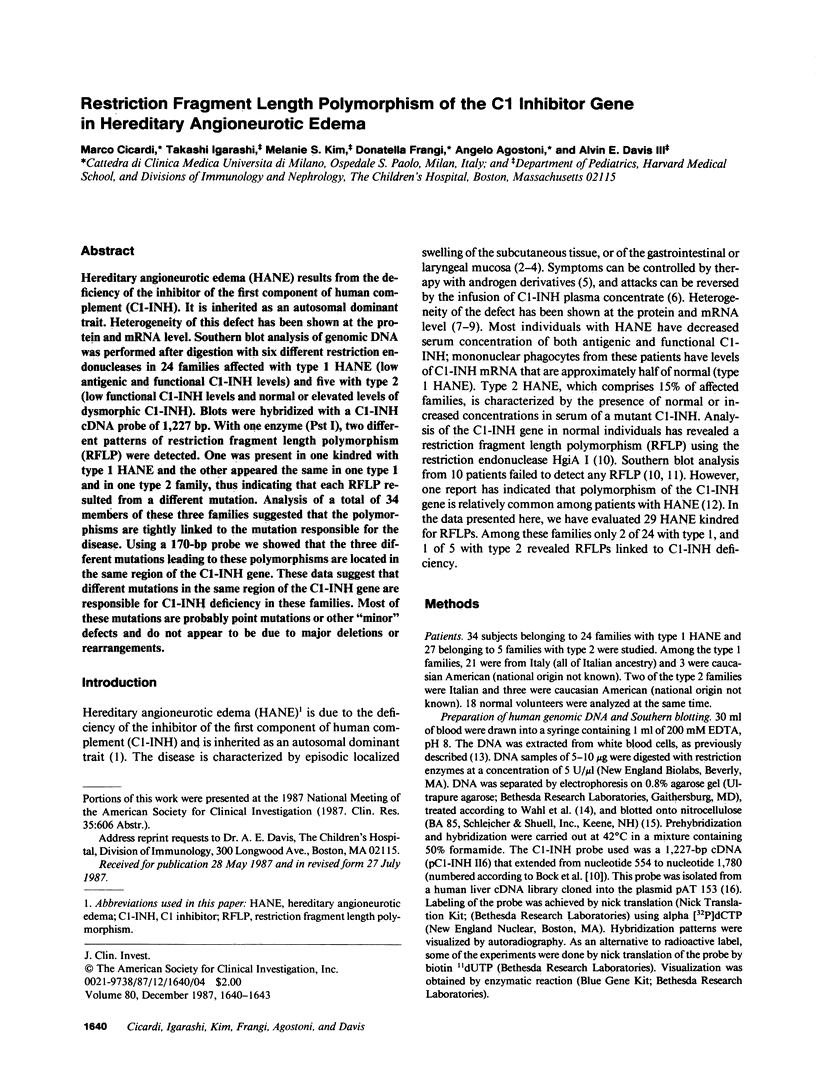
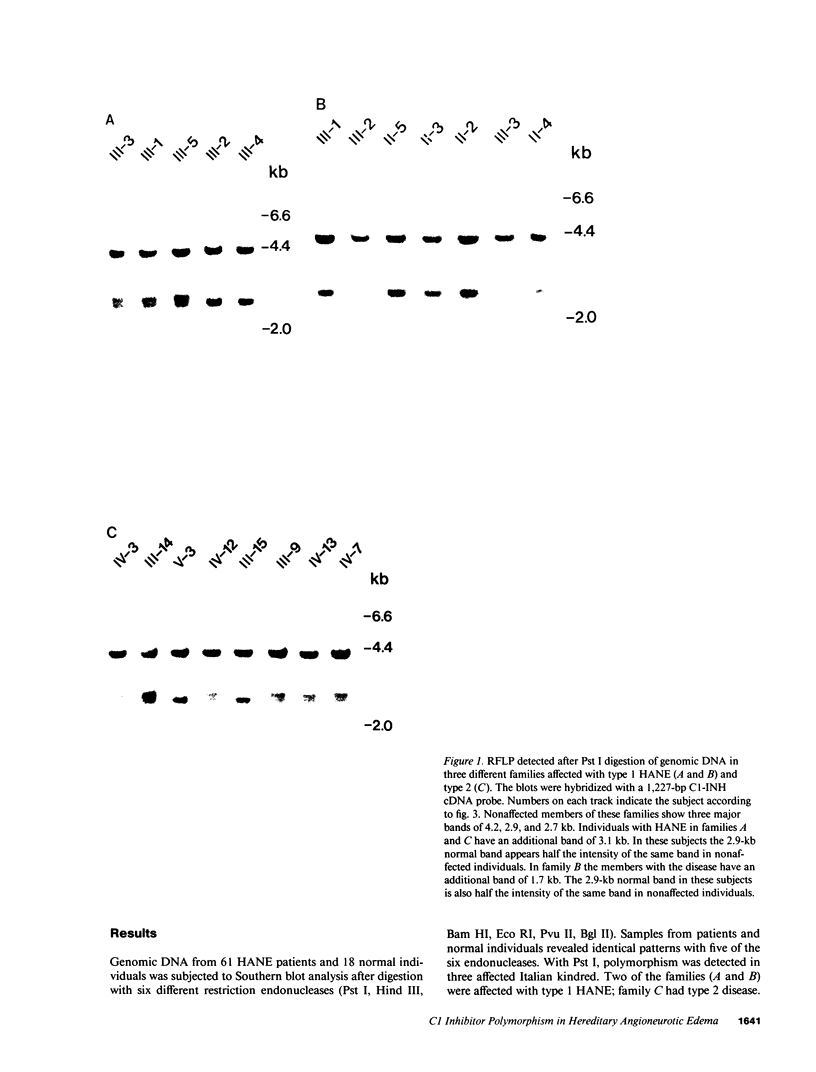
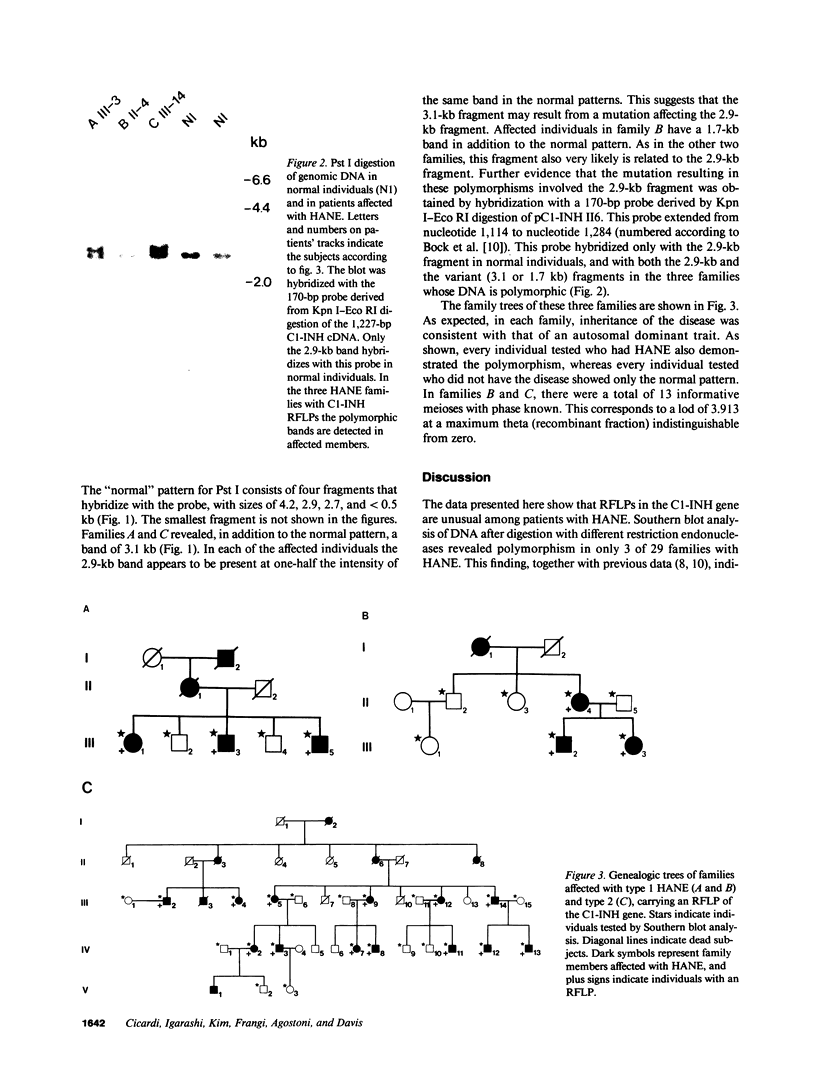

Images in this article
Selected References
These references are in PubMed. This may not be the complete list of references from this article.
- Bergamaschini L., Cicardi M., Tucci A., Gardinali M., Frangi D., Valle C., Agostoni A. C1 INH concentrate in the therapy of hereditary angioedema. Allergy. 1983 Feb;38(2):81–84. doi: 10.1111/j.1398-9995.1983.tb01590.x. [DOI] [PubMed] [Google Scholar]
- Bock S. C., Skriver K., Nielsen E., Thøgersen H. C., Wiman B., Donaldson V. H., Eddy R. L., Marrinan J., Radziejewska E., Huber R. Human C1 inhibitor: primary structure, cDNA cloning, and chromosomal localization. Biochemistry. 1986 Jul 29;25(15):4292–4301. doi: 10.1021/bi00363a018. [DOI] [PubMed] [Google Scholar]
- Brickman C. M., Tsokos G. C., Balow J. E., Lawley T. J., Santaella M., Hammer C. H., Frank M. M. Immunoregulatory disorders associated with hereditary angioedema. I. Clinical manifestations of autoimmune disease. J Allergy Clin Immunol. 1986 May;77(5):749–757. doi: 10.1016/0091-6749(86)90424-0. [DOI] [PubMed] [Google Scholar]
- Brickman C. M., Tsokos G. C., Chused T. M., Balow J. E., Lawley T. J., Santaella M., Hammer C. H., Linton G. F., Frank M. M. Immunoregulatory disorders associated with hereditary angioedema. II. Serologic and cellular abnormalities. J Allergy Clin Immunol. 1986 May;77(5):758–767. doi: 10.1016/0091-6749(86)90425-2. [DOI] [PubMed] [Google Scholar]
- Cicardi M., Igarashi T., Rosen F. S., Davis A. E., 3rd Molecular basis for the deficiency of complement 1 inhibitor in type I hereditary angioneurotic edema. J Clin Invest. 1987 Mar;79(3):698–702. doi: 10.1172/JCI112873. [DOI] [PMC free article] [PubMed] [Google Scholar]
- Colten H. R. Hereditary angioneurotic edema, 1887 to 1987. N Engl J Med. 1987 Jul 2;317(1):43–45. doi: 10.1056/NEJM198707023170108. [DOI] [PubMed] [Google Scholar]
- DONALDSON V. H., EVANS R. R. A BIOCHEMICAL ABNORMALITY IN HEREDIATRY ANGIONEUROTIC EDEMA: ABSENCE OF SERUM INHIBITOR OF C' 1-ESTERASE. Am J Med. 1963 Jul;35:37–44. doi: 10.1016/0002-9343(63)90162-1. [DOI] [PubMed] [Google Scholar]
- Davis A. E., 3rd, Whitehead A. S., Harrison R. A., Dauphinais A., Bruns G. A., Cicardi M., Rosen F. S. Human inhibitor of the first component of complement, C1: characterization of cDNA clones and localization of the gene to chromosome 11. Proc Natl Acad Sci U S A. 1986 May;83(10):3161–3165. doi: 10.1073/pnas.83.10.3161. [DOI] [PMC free article] [PubMed] [Google Scholar]
- Gadek J. E., Hosea S. W., Gelfand J. A., Frank M. M. Response of variant hereditary angioedema phenotypes to danazol therapy. Genetic implications. J Clin Invest. 1979 Jul;64(1):280–286. doi: 10.1172/JCI109449. [DOI] [PMC free article] [PubMed] [Google Scholar]
- Gelfand J. A., Sherins R. J., Alling D. W., Frank M. M. Treatment of hereditary angioedema with danazol. Reversal of clinical and biochemical abnormalities. N Engl J Med. 1976 Dec 23;295(26):1444–1448. doi: 10.1056/NEJM197612232952602. [DOI] [PubMed] [Google Scholar]
- Rosen F. S., Alper C. A., Pensky J., Klemperer M. R., Donaldson V. H. Genetically determined heterogeneity of the C1 esterase inhibitor in patients with hereditary angioneurotic edema. J Clin Invest. 1971 Oct;50(10):2143–2149. doi: 10.1172/JCI106708. [DOI] [PMC free article] [PubMed] [Google Scholar]
- Southern E. M. Detection of specific sequences among DNA fragments separated by gel electrophoresis. J Mol Biol. 1975 Nov 5;98(3):503–517. doi: 10.1016/s0022-2836(75)80083-0. [DOI] [PubMed] [Google Scholar]
- Tosi M., Duponchel C., Bourgarel P., Colomb M., Meo T. Molecular cloning of human C1 inhibitor: sequence homologies with alpha 1-antitrypsin and other members of the serpins superfamily. Gene. 1986;42(3):265–272. doi: 10.1016/0378-1119(86)90230-1. [DOI] [PubMed] [Google Scholar]
- Wahl G. M., Stern M., Stark G. R. Efficient transfer of large DNA fragments from agarose gels to diazobenzyloxymethyl-paper and rapid hybridization by using dextran sulfate. Proc Natl Acad Sci U S A. 1979 Aug;76(8):3683–3687. doi: 10.1073/pnas.76.8.3683. [DOI] [PMC free article] [PubMed] [Google Scholar]
- Whitehead A. S., Woods D. E., Fleischnick E., Chin J. E., Yunis E. J., Katz A. J., Gerald P. S., Alper C. A., Colten H. R. DNA polymorphism of the C4 genes. A new marker for analysis of the major histocompatibility complex. N Engl J Med. 1984 Jan 12;310(2):88–91. doi: 10.1056/NEJM198401123100204. [DOI] [PubMed] [Google Scholar]



